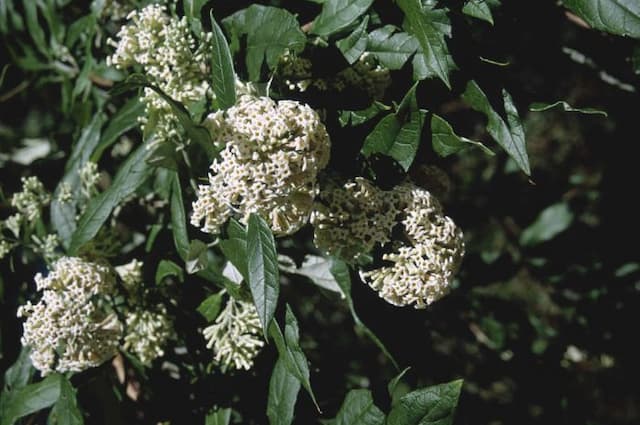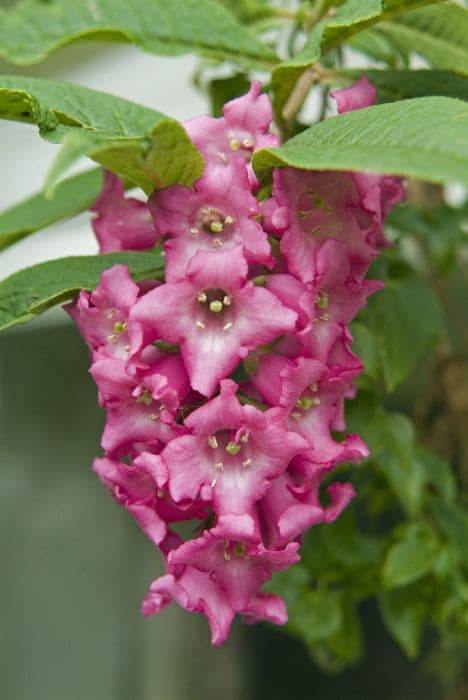Butterfly Bush Buddleja davidii 'White Cloud'

ABOUT
Buddleja davidii 'White Cloud', commonly known as the Butterfly Bush, is a deciduous shrub recognized for its bountiful blooms and attractiveness to butterflies. It has arching branches that bear lance-shaped, pointed leaves with a grayish-green hue and a slightly fuzzy texture. The foliage provides a soft backdrop to the plant's standout feature: stunning, dense clusters of tiny, tubular white flowers. These flowers typically present themselves in elongated cone-shaped panicles that cascade gently along the lengths of the branches. These flower clusters exude a delicate fragrance that is irresistible to butterflies, bees, and other beneficial pollinators, hence the common name 'Butterfly Bush.' The flowering period of the Butterfly Bush is quite generous, often extending from mid-summer to early fall, bringing a continuous display of white blossoms that can provide a striking contrast to the darker greens in the garden. As the plant matures, it may form a sprawled structure, offering an informal, almost wild appearance, which enhances its cottage garden charm. After the blooms have spent their splendor, they give way to small, brownish-gray seed capsules that can add textural interest to the plant in the off-season. Overall, the White Cloud Butterfly Bush is celebrated for its lush foliage, elegant white blooms, and its role as a magnet for various pollinating insects, all of which make it a highly desirable addition to many garden settings.
About this plant
 Names
NamesSynonyms
Butterfly Bush, Summer Lilac, Orange Eye.
Common names
Buddleja davidii var. alba, Buddleja davidii f. alba, Buddleja davidii 'Alba', Buddleja davidii 'Pekinensis Alba'.
 Toxicity
ToxicityTo humans
Butterfly Bush is generally not considered poisonous to humans. It does not contain any known toxins that would cause symptoms of poisoning when touched or ingested. However, as with many plants, individual allergic reactions or sensitivities are possible. If any part of the plant is ingested and symptoms do occur, it is important to consult healthcare professionals.
To pets
Butterfly Bush is also not known to be toxic to pets. While not considered a poisonous plant, it's still a good practice to prevent pets from ingesting plant material, as it may cause gastrointestinal upset or an allergic reaction in some animals. If a pet exhibits unusual symptoms after consuming any part of the plant, it is advisable to contact a veterinarian.
 Characteristics
CharacteristicsLife cycle
Perennials
Foliage type
Deciduous
Color of leaves
Green
Flower color
White
Height
6 feet (1.83 meters)
Spread
8 feet (2.44 meters)
Plant type
Shrub
Hardiness zones
5
Native area
China
Benefits
 General Benefits
General Benefits- Attracts Pollinators: The 'White Cloud' variety is a valuable source of nectar for butterflies, bees, and other beneficial insects.
- Ease of Care: This shrub is known for being low-maintenance, requiring minimal attention once established.
- Drought Resistance: Once established, it can tolerate periods of low water, making it suitable for xeriscaping and water-wise gardens.
- Rapid Growth: It has a fast growth rate, quickly filling in spaces in the landscape and providing privacy.
- Deer Resistant: Generally resistant to deer, which makes it a good choice for areas where deer browsing is a problem.
- Long Blooming Period: Offers long-lasting blooms from early summer to the first frost, providing extended visual interest.
- Winter Interest: The shrub's structure and seed heads can provide visual interest in the garden during the winter months.
- Versatile Landscaping: It can be used in various garden settings, including mixed borders, butterfly gardens, and as standalone specimens or hedges.
- Year-Round Interest: With its silvery-green foliage and white flowers, it provides a contrasting element among other plants in a garden landscape.
- Tolerates Poor Soil: Capable of growing in a range of soil types, even those with low fertility, although it prefers well-draining soil.
 Medical Properties
Medical PropertiesThis plant is not used for medical purposes.
 Air-purifying Qualities
Air-purifying QualitiesThis plant is not specifically known for air purifying qualities.
 Other Uses
Other Uses- Wildlife Habitat: The White Cloud provides shelter and breeding places for butterflies, bees, and other beneficial insects.
- Erosion Control: It can be planted on slopes or banks to help stabilize the soil and prevent erosion.
- Privacy Screen: Its dense growth habit makes it suitable for use as a living privacy screen or hedge.
- Artistic Craft: The branches can be dried and used in floral arrangements or as part of craft projects.
- Photography: Buddleja davidii 'White Cloud' serves as an excellent subject for photographers, particularly during its bloom period.
- Education: The plant can be used to educate on pollination and the life cycle of butterflies in schools and butterfly gardens.
- Windbreak: When planted in rows, it acts as a windbreak to protect gardens or property from strong winds.
- Urban Greening: The plant can be used in urban planting schemes to green up cities and contribute to biodiversity.
- Cultural Significance: In some cultures, the White Cloud is planted in gardens for its symbolism of peace and purity.
- Nature-Inspired Design: Landscape architects and designers may use Buddleja davidii 'White Cloud' for its aesthetic appeal in creating naturalistic garden designs.
Interesting Facts
 Feng Shui
Feng ShuiThe Butterfly Bush is not used in Feng Shui practice.
 Zodiac Sign Compitability
Zodiac Sign CompitabilityThe Butterfly Bush is not used in astrology practice.
 Plant Symbolism
Plant Symbolism- Transformation and Renewal: The Buddleja davidii 'White Cloud', commonly known as the Butterfly Bush, attracts a host of butterflies which traditionally symbolize transformation and renewal due to their life cycle.
- Attraction: As this plant is a natural magnet for butterflies and other insects, it represents the power of attraction and the ability to draw in surrounding energy or beings.
- Beauty: The Butterfly Bush's lush white blooms are suggestive of beauty and grace. It's a common symbol for visual and aesthetic pleasure.
- Healing: Traditionally, some Buddleja species have been used in medicine. As such, it can symbolize healing and nurturing.
- Peace and Purity: The color white is often associated with peace and purity, and so the 'White Cloud' variety of Butterfly Bush carries these meanings too.
 Water
WaterThe Butterfly Bush (Buddleja davidii 'White Cloud') requires consistent moisture, but it's important to avoid overwatering. During the growing season, water the plant deeply once a week, ensuring that the soil is moist but well-draining. If the weather is particularly hot or dry, watering frequency may need to increase to twice a week. Each watering session should provide approximately one to two gallons of water to the root zone. During the winter months, reduce watering as the plant goes dormant and only water if the soil becomes very dry.
 Light
LightThe Butterfly Bush thrives in full sun conditions, requiring at least 6 to 8 hours of direct sunlight daily. It’s best planted in a spot where it can receive unfiltered, bright light throughout the day to promote healthy growth and abundant blooming. Partial shade is tolerable, but flowering may be reduced.
 Temperature
TemperatureThe Butterfly Bush is cold hardy and can withstand temperatures as low as 20°F but performs best in a range between 60°F and 90°F. While it can endure brief periods of colder weather, prolonged exposure to temperatures below 20°F may damage or kill the plant. In terms of heat, it can handle high temperatures but ensure it has adequate water in extreme heat to prevent stress.
 Pruning
PruningPruning is essential for the Butterfly Bush to maintain its shape, encourage new growth, and promote more prolific blooming. Prune in late winter or early spring before new growth starts. Cut back the entire plant to about 12 inches from the ground to stimulate fresh growth. This hard pruning can be done annually, as the Butterfly Bush flowers on new wood.
 Cleaning
CleaningAs needed
 Soil
SoilButterfly Bush 'White Cloud' thrives in well-drained soil with high fertility. A mixture of garden soil, compost, and a bit of sand or perlite to ensure drainage works best for this plant. The ideal soil pH for 'White Cloud' is between 6.0 and 7.0. Mulching around the base can help retain moisture and suppress weeds.
 Repotting
RepottingButterfly Bush 'White Cloud' typically does not require frequent repotting since it's often grown as a large shrub in gardens. However, if grown in containers, it should be repotted every 2 to 3 years to ensure it has enough space for root growth and to refresh the soil.
 Humidity & Misting
Humidity & MistingButterfly Bush 'White Cloud' is adaptable to a wide range of humidity conditions and does not require any special humidity levels to thrive. It performs well in the humidity levels typically found in most outdoor environments.
 Suitable locations
Suitable locationsIndoor
Grow in bright light and well-draining soil.
Outdoor
Plant in full sun and water deeply when soil is dry.
Hardiness zone
5-10 USDA
 Life cycle
Life cycleBuddleja davidii 'White Cloud', commonly known as Butterfly Bush, begins its life cycle when seeds germinate, usually in early spring if sown outdoors. The seedlings develop into young plants, with rapid stem and leaf growth throughout the spring and early summer. During late summer, it reaches maturity and produces panicles of fragrant, white flowers that attract butterflies and other pollinators. After pollination, it sets seed which are dispersed by wind or wildlife. The plant becomes dormant in winter, with the woody stems surviving cold conditions. In spring, the cycle starts anew with the plant producing fresh growth from the old wood.
 Propogation
PropogationPropogation time
Spring-Early Summer
The Butterfly Bush 'White Cloud' is commonly propagated by semi-hardwood cuttings. The best time to take these cuttings is in late summer after the bloom period has ended and the current year's growth is beginning to mature. One should select healthy stems with several sets of leaves, and make cuttings of about 4-6 inches (10-15 cm) in length. Remove the leaves from the lower half of the cutting to prevent moisture loss and excess transpiration. The cut end of the cutting can be dipped in rooting hormone to encourage root development. Then, the cuttings should be placed in a well-draining soil mix, ensuring at least one or two nodes are buried where new roots are likely to form. It's essential to keep the soil consistently moist but not waterlogged and to provide a warm environment with indirect light. Under optimal conditions, roots will start forming within a few weeks.

![Butterfly bush [Berries and Cream]](/_next/image?url=https%3A%2F%2Fplants-admin.emdemapps.com%2Fimages%2Fplants%2F%2Fimages%2F604b650f667be.png&w=640&q=75)





![Butterfly bush [Nanho Purple]](/_next/image?url=https%3A%2F%2Fplants-admin.emdemapps.com%2Fimages%2Fplants%2F%2Fimages%2F604b5e3cb2c58.png&w=640&q=75)
